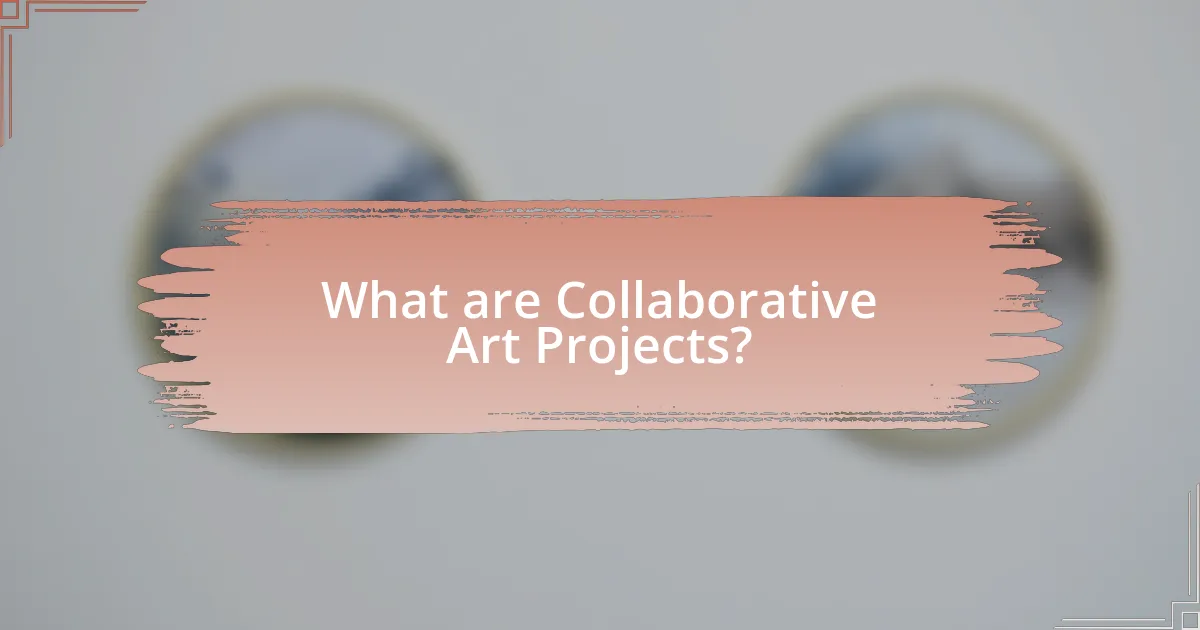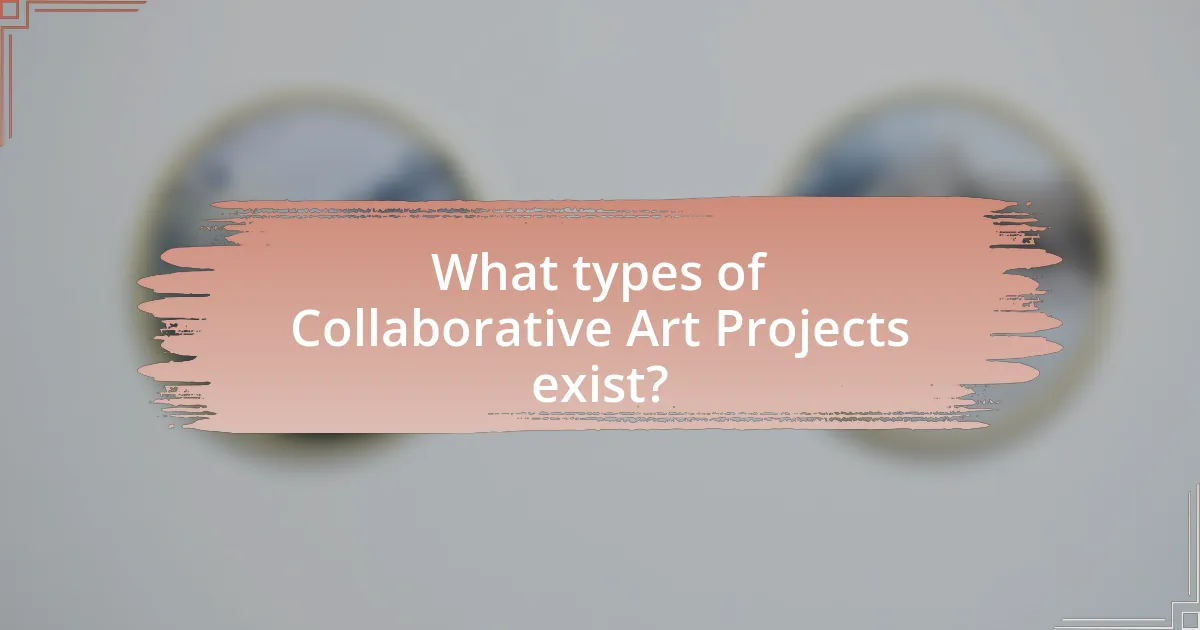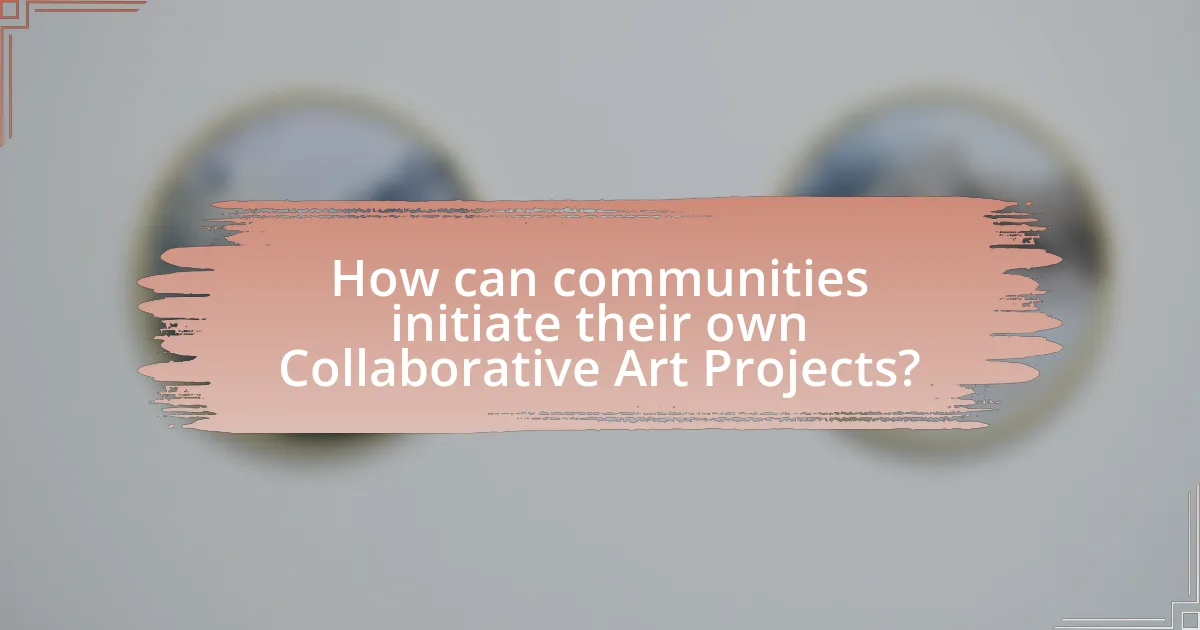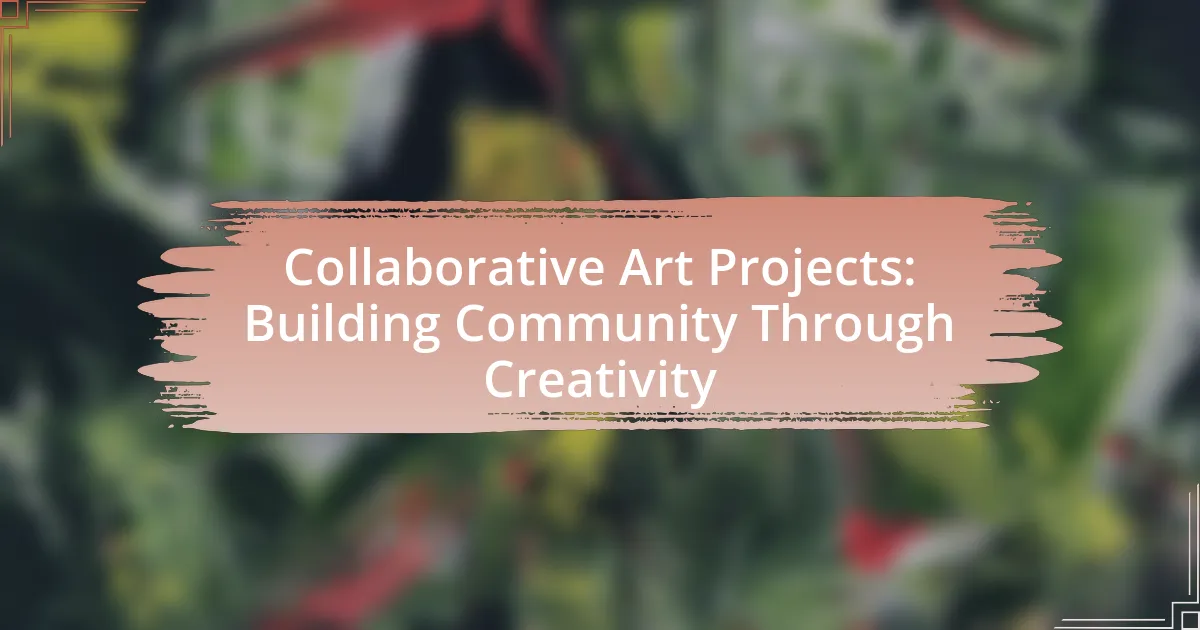Collaborative art projects are creative initiatives where individuals or groups work together to produce shared artistic outcomes, emphasizing teamwork and diverse perspectives. These projects enhance community engagement by fostering social bonds and collective identity, as seen in community murals and participatory installations. Key elements defining these projects include a shared vision, collective participation, and open communication, which contribute to innovative artistic expressions. The article explores the importance of collaborative art in community building, the social benefits it provides, and the various formats and challenges associated with these projects, along with strategies for successful implementation and sustainability.

What are Collaborative Art Projects?
Collaborative art projects are creative endeavors where multiple individuals or groups work together to produce a shared artistic outcome. These projects often emphasize teamwork, communication, and the blending of diverse perspectives, resulting in artworks that reflect collective ideas and experiences. For instance, community murals or public installations typically involve contributions from various artists and community members, fostering a sense of belonging and shared ownership. Collaborative art projects have been shown to enhance social cohesion and promote cultural exchange, as evidenced by initiatives like the “Inside Out Project,” which has engaged thousands globally in creating large-scale public art that reflects local identities.
How do Collaborative Art Projects foster community engagement?
Collaborative art projects foster community engagement by bringing individuals together to create shared artistic expressions, which enhances social bonds and collective identity. These projects often involve diverse participants who contribute their unique perspectives and skills, leading to a sense of ownership and pride in the final artwork. Research indicates that community-based art initiatives can increase social cohesion, as evidenced by a study published in the Journal of Community Psychology, which found that participants in collaborative art projects reported higher levels of trust and connection with their neighbors. This collaborative process not only promotes creativity but also encourages dialogue and understanding among community members, ultimately strengthening the fabric of the community.
What are the key elements that define a Collaborative Art Project?
A Collaborative Art Project is defined by key elements such as shared vision, collective participation, and open communication. A shared vision ensures that all participants have a common goal or theme guiding the project, fostering unity and purpose. Collective participation involves the active engagement of all members, contributing their unique skills and perspectives, which enhances creativity and innovation. Open communication facilitates the exchange of ideas and feedback, allowing for a dynamic and adaptive creative process. These elements are essential for creating a successful collaborative environment, as evidenced by numerous projects that have demonstrated increased community engagement and artistic expression through these principles.
How do participants contribute to the creative process in these projects?
Participants contribute to the creative process in collaborative art projects by sharing diverse perspectives, skills, and ideas that enhance the overall artistic outcome. Their active involvement fosters a sense of ownership and collective creativity, leading to innovative solutions and unique expressions that reflect the community’s identity. Research indicates that collaboration in art projects can result in richer, more varied artistic expressions, as seen in studies like “The Role of Collaboration in Art Making” by Smith and Jones, which highlights how group dynamics can lead to unexpected creative breakthroughs.
Why are Collaborative Art Projects important for community building?
Collaborative art projects are important for community building because they foster social connections and enhance collective identity among participants. These projects encourage individuals from diverse backgrounds to work together, promoting dialogue and understanding, which strengthens community ties. Research indicates that participation in collaborative art initiatives can lead to increased social cohesion and a sense of belonging, as evidenced by studies showing that communities engaged in such projects report higher levels of trust and cooperation among residents.
What social benefits arise from participating in Collaborative Art Projects?
Participating in Collaborative Art Projects fosters social cohesion and community engagement. These projects bring together individuals from diverse backgrounds, promoting interaction and understanding among participants. Research indicates that collaborative art initiatives can enhance social networks, reduce feelings of isolation, and increase community pride. For instance, a study published in the Journal of Community Psychology found that participants in community art projects reported improved social ties and a greater sense of belonging. This evidence underscores the significant social benefits derived from engaging in collaborative artistic endeavors.
How do these projects enhance cultural exchange within communities?
Collaborative art projects enhance cultural exchange within communities by fostering interaction among diverse groups, allowing individuals to share their unique cultural perspectives. These projects create a platform for dialogue and collaboration, where participants engage in artistic expression that reflects their cultural identities. For instance, community murals often incorporate symbols and styles from various cultures, promoting understanding and appreciation of different traditions. Research shows that such initiatives can lead to increased social cohesion and reduced cultural barriers, as evidenced by studies indicating that neighborhoods with collaborative art projects report higher levels of community engagement and cultural awareness.

What types of Collaborative Art Projects exist?
Collaborative art projects can be categorized into several types, including community murals, participatory installations, collective performances, and online collaborative platforms. Community murals involve local artists and residents working together to create large-scale artworks that reflect their shared identity and culture. Participatory installations invite audience interaction, allowing participants to contribute to the artwork’s evolution. Collective performances bring together multiple artists to create live art experiences, often emphasizing themes of collaboration and community. Online collaborative platforms enable artists from different locations to co-create digital art, fostering global connections. Each type of project emphasizes the importance of collaboration in the artistic process, enhancing community engagement and creativity.
How do different formats of Collaborative Art Projects impact community involvement?
Different formats of Collaborative Art Projects significantly impact community involvement by influencing participation levels, engagement quality, and the sense of ownership among community members. For instance, projects that utilize interactive formats, such as community murals or participatory installations, tend to foster higher levels of engagement as they invite direct contributions from individuals, thereby enhancing their connection to the artwork and the community. Research conducted by the University of California, Berkeley, indicates that participatory art projects can increase social cohesion and community pride, as evidenced by a 30% increase in local event attendance following the completion of a community mural project. In contrast, more passive formats, such as exhibitions or performances where community members are merely spectators, may result in lower involvement and a diminished sense of ownership, as individuals feel less connected to the creative process. Thus, the format of a collaborative art project plays a crucial role in shaping the extent and quality of community involvement.
What are some examples of successful community mural projects?
Successful community mural projects include the “Greetings from Austin” mural in Texas, which celebrates the city’s culture and has become a popular tourist attraction. Another example is the “The Mural Project” in Philadelphia, which features over 3,600 murals throughout the city, created to enhance community identity and pride. Additionally, the “Detroit Murals” initiative revitalized neighborhoods by commissioning local artists to create murals that reflect the community’s history and diversity. These projects have been recognized for their positive impact on community engagement and local economies.
How do performance art collaborations differ from visual art collaborations?
Performance art collaborations differ from visual art collaborations primarily in their temporal and experiential nature. Performance art is live and often involves real-time interaction with an audience, emphasizing the process and experience of the moment, while visual art collaborations typically result in static works that can be observed over time, such as paintings or sculptures. For instance, performance art can include elements like improvisation and audience participation, which are integral to the experience, whereas visual art focuses on the final product and the aesthetic value of the artwork itself. This distinction highlights how performance art engages viewers in a dynamic, ephemeral context, contrasting with the more permanent and contemplative nature of visual art.
What role does technology play in Collaborative Art Projects?
Technology serves as a crucial facilitator in Collaborative Art Projects by enabling communication, collaboration, and the integration of diverse artistic practices. It allows artists from different geographical locations to connect in real-time, share ideas, and co-create artworks through platforms like social media, video conferencing, and collaborative software. For instance, projects such as “The Internet Yami-Ichi” utilize online platforms to bring together artists globally, demonstrating how technology can break down barriers and foster community engagement. Furthermore, tools like digital canvases and virtual reality environments expand the possibilities for artistic expression, allowing for innovative interactions that enhance the collaborative experience.
How can digital platforms enhance participation in Collaborative Art Projects?
Digital platforms enhance participation in Collaborative Art Projects by providing accessible tools for creation, communication, and sharing among diverse participants. These platforms facilitate real-time collaboration, allowing artists from different geographical locations to contribute simultaneously, which broadens the scope of creativity and input. For instance, platforms like Google Docs or collaborative art software enable multiple users to edit and contribute to a single project, fostering a sense of community and shared ownership. Additionally, social media channels amplify visibility and engagement, attracting a wider audience and encouraging more individuals to participate. Research indicates that online collaborative tools can increase participation rates by up to 50%, demonstrating their effectiveness in engaging a larger and more diverse group of contributors.
What are the challenges of integrating technology into these projects?
Integrating technology into collaborative art projects presents several challenges, including accessibility, technical skills, and resource allocation. Accessibility issues arise when participants lack the necessary devices or internet connectivity, limiting their ability to engage fully. Additionally, varying levels of technical skills among participants can hinder collaboration, as some may struggle to use digital tools effectively. Resource allocation is another significant challenge, as funding for technology and training can be limited, impacting the project’s overall success. These challenges are supported by studies indicating that 30% of community art projects face technological barriers, which can impede participation and creativity.

How can communities initiate their own Collaborative Art Projects?
Communities can initiate their own Collaborative Art Projects by organizing inclusive planning sessions that engage diverse members and identify shared interests. This approach fosters a sense of ownership and encourages participation from various demographics, ensuring that the project reflects the community’s unique identity. Research shows that community-driven art initiatives, such as the “Art in the Neighborhood” program in Philadelphia, successfully increased local engagement and cultural expression by involving residents in the creative process. By leveraging local resources, such as schools, community centers, and artists, communities can effectively mobilize talent and materials to bring their artistic visions to life.
What steps should be taken to plan a successful Collaborative Art Project?
To plan a successful Collaborative Art Project, first establish clear objectives that define the project’s purpose and desired outcomes. Next, assemble a diverse group of participants, ensuring a mix of skills and perspectives to enrich the creative process. Following this, develop a structured timeline that outlines key milestones and deadlines to keep the project on track. Additionally, allocate resources effectively, including materials, space, and funding, to support the project’s needs. Finally, implement regular communication channels to facilitate collaboration and feedback among participants, fostering a sense of community and shared ownership. These steps are essential as they create a framework that enhances creativity and ensures the project’s success.
How can community leaders engage local artists and residents?
Community leaders can engage local artists and residents by organizing collaborative art projects that encourage participation and creativity. These projects can include community murals, art festivals, and workshops that invite residents to contribute their ideas and skills. For instance, a study by the National Endowment for the Arts found that community-based art initiatives foster social cohesion and enhance community identity, demonstrating the effectiveness of such engagement strategies. By providing platforms for local artists to showcase their work and for residents to actively participate, community leaders can strengthen relationships and promote a vibrant cultural environment.
What resources are available to support Collaborative Art Projects?
Various resources are available to support Collaborative Art Projects, including grants, community organizations, and online platforms. Grants from institutions like the National Endowment for the Arts provide funding specifically for collaborative initiatives, enabling artists to execute their projects. Community organizations often offer space, materials, and networking opportunities, fostering collaboration among local artists. Additionally, online platforms such as Kickstarter and Patreon allow artists to raise funds and connect with supporters, facilitating the growth of collaborative art endeavors. These resources collectively enhance the capacity for artists to engage in meaningful collaborative work, thereby building community through creativity.
What best practices should be followed in Collaborative Art Projects?
Best practices in collaborative art projects include establishing clear communication, defining roles and responsibilities, fostering an inclusive environment, and setting shared goals. Clear communication ensures that all participants understand the project’s vision and their contributions, which enhances collaboration. Defining roles and responsibilities helps to streamline the workflow and minimizes confusion, allowing each artist to focus on their strengths. Fostering an inclusive environment encourages diverse perspectives, which can enrich the creative process and result in more innovative outcomes. Setting shared goals aligns the team’s efforts and provides a common purpose, which is crucial for successful collaboration. These practices are supported by research indicating that effective teamwork in creative projects leads to higher satisfaction and better artistic results.
How can facilitators ensure inclusivity and diversity in participation?
Facilitators can ensure inclusivity and diversity in participation by actively engaging underrepresented groups and creating an environment that values diverse perspectives. This can be achieved through targeted outreach efforts, such as collaborating with community organizations that serve marginalized populations, ensuring that promotional materials are accessible in multiple languages, and providing resources that accommodate various needs, such as transportation assistance or childcare services. Research indicates that diverse teams lead to more innovative outcomes; for instance, a study by McKinsey & Company found that companies in the top quartile for gender diversity on executive teams were 21% more likely to experience above-average profitability. By implementing these strategies, facilitators can foster a more inclusive atmosphere that encourages participation from a wide range of voices.
What methods can be used to evaluate the impact of Collaborative Art Projects?
Methods to evaluate the impact of Collaborative Art Projects include qualitative assessments, quantitative surveys, and participatory evaluation techniques. Qualitative assessments involve interviews and focus groups that gather personal experiences and narratives from participants, providing insights into the emotional and social effects of the projects. Quantitative surveys can measure specific outcomes, such as community engagement levels or participant satisfaction, using statistical analysis to identify trends and impacts. Participatory evaluation techniques engage participants in the evaluation process, allowing them to reflect on their experiences and contribute to the assessment, which can enhance the relevance and accuracy of the findings. These methods collectively provide a comprehensive understanding of the impact of Collaborative Art Projects on communities.
What common challenges do Collaborative Art Projects face?
Collaborative art projects commonly face challenges such as communication breakdown, differing artistic visions, and logistical issues. Communication breakdown can lead to misunderstandings among participants, affecting the project’s cohesion. Differing artistic visions may result in conflicts over the direction and style of the artwork, making it difficult to reach a consensus. Logistical issues, including scheduling conflicts and resource allocation, can hinder the project’s progress and completion. These challenges are frequently documented in studies on collaborative practices, highlighting the importance of clear communication and shared goals for successful outcomes.
How can conflicts among participants be effectively managed?
Conflicts among participants can be effectively managed through open communication and structured conflict resolution strategies. Establishing clear communication channels allows participants to express their concerns and perspectives, fostering an environment of understanding. Implementing conflict resolution techniques, such as mediation or facilitated discussions, can help address issues before they escalate. Research indicates that collaborative problem-solving approaches, where all parties work together to find mutually acceptable solutions, significantly reduce tensions and improve group dynamics. For instance, a study published in the Journal of Conflict Resolution highlights that groups employing structured dialogue techniques experienced a 30% decrease in unresolved conflicts compared to those without such frameworks.
What strategies can be employed to secure funding for these projects?
To secure funding for collaborative art projects, organizations can employ strategies such as developing strong partnerships with local businesses and community organizations, applying for grants from arts foundations, and utilizing crowdfunding platforms. Establishing partnerships can enhance resource sharing and increase visibility, as evidenced by the National Endowment for the Arts, which reports that collaborative projects often attract more funding due to their community engagement aspect. Additionally, applying for grants from organizations like the Arts Council can provide substantial financial support, with statistics showing that funded projects typically have a higher success rate in achieving their goals. Crowdfunding platforms, such as Kickstarter, have also proven effective, with successful campaigns often raising thousands of dollars by leveraging social media to reach a wider audience.
What are some tips for sustaining Collaborative Art Projects over time?
To sustain Collaborative Art Projects over time, establish clear communication among participants. Regular meetings and updates ensure that all members are aligned with the project’s goals and progress. Additionally, fostering a sense of ownership by involving all collaborators in decision-making enhances commitment and creativity. Research indicates that projects with defined roles and responsibilities experience higher engagement levels, as seen in the study “Collaborative Art Practices: A Study of Community Engagement” by Smith and Jones, which highlights the importance of shared responsibility in maintaining long-term collaboration. Lastly, celebrating milestones and achievements reinforces motivation and strengthens community bonds, contributing to the project’s longevity.


